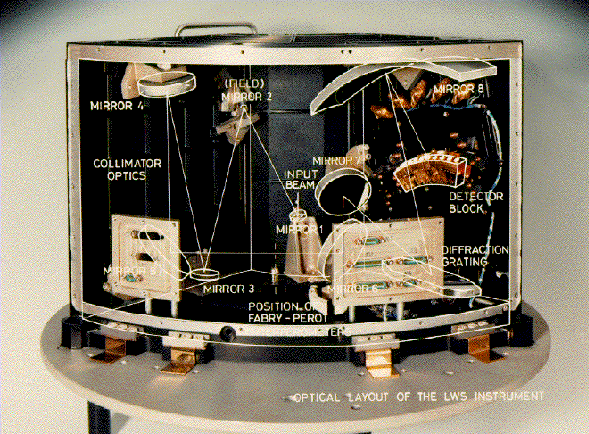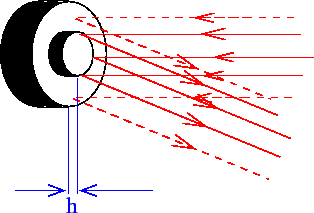Radiation from an astronomical source entered the ISO telescope, which
was a 60cm diameter (![]() ) Ritchey-Chrétien system with an overall
focal ratio of
) Ritchey-Chrétien system with an overall
focal ratio of ![]() (
(![]() , where
, where ![]() is the effective telescope
focal length).
The telescope plate scale is given by
is the effective telescope
focal length).
The telescope plate scale is given by
![]() and is 22.9
and is 22.9
![]() /mm; i.e. an object of
22.9
/mm; i.e. an object of
22.9
![]() on the sky had a linear size of 1mm in the
focal plane of the telescope. The
radiation was divided into four beams, one for each ISO instrument, by a
pyramidal mirror near the Cassegrain focus. Figure 2.1
shows the path radiation took through the LWS, superimposed on a
photograph of the instrument taken before the integration of the
Fabry-Pérot subsystem. After entering the LWS it was reflected from
Mirror 1 onto Mirror 2, which was coincident with the telescope
focus. The size of Mirror 2 thus precisely defined the Field of View (FOV)
on the sky for the LWS. At these extreme infrared wavelengths the
spatial resolution of the ISO telescope was completely determined by
diffraction, with an achievable spatial resolution of
on the sky had a linear size of 1mm in the
focal plane of the telescope. The
radiation was divided into four beams, one for each ISO instrument, by a
pyramidal mirror near the Cassegrain focus. Figure 2.1
shows the path radiation took through the LWS, superimposed on a
photograph of the instrument taken before the integration of the
Fabry-Pérot subsystem. After entering the LWS it was reflected from
Mirror 1 onto Mirror 2, which was coincident with the telescope
focus. The size of Mirror 2 thus precisely defined the Field of View (FOV)
on the sky for the LWS. At these extreme infrared wavelengths the
spatial resolution of the ISO telescope was completely determined by
diffraction, with an achievable spatial resolution of
![]() 83
83
![]() (
(
![]() ) at the longest
wavelength (
) at the longest
wavelength (![]() ).
Although this lowers with decreasing wavelength, the LWS
was designed to detect this longest wavelength with reasonable
efficiency yet have a nearly constant FOV on the sky.
A study of the intensity received from a point source as a function of
the focal plane aperture size by Duncan 1983, [14] showed
that the diameter
of the central Airy diffraction disc (
).
Although this lowers with decreasing wavelength, the LWS
was designed to detect this longest wavelength with reasonable
efficiency yet have a nearly constant FOV on the sky.
A study of the intensity received from a point source as a function of
the focal plane aperture size by Duncan 1983, [14] showed
that the diameter
of the central Airy diffraction disc (
![]() ) can
be reduced to about 65% before significant losses occur.
Note that the energy within the central spot of the Airy disc is 84%,
whilst Figure 5 of
Duncan 1983, [14] shows that this only reduces to
) can
be reduced to about 65% before significant losses occur.
Note that the energy within the central spot of the Airy disc is 84%,
whilst Figure 5 of
Duncan 1983, [14] shows that this only reduces to
![]() 72% with an iris set to 0.65 of the Airy disc diameter.
For the longest LWS wavelength this gave a diameter of
72% with an iris set to 0.65 of the Airy disc diameter.
For the longest LWS wavelength this gave a diameter of ![]() mm
(
mm
(
![]() ), which was the criterion used
to set the size of Mirror 2. The maximum geometrical FOV for the LWS was
given by
), which was the criterion used
to set the size of Mirror 2. The maximum geometrical FOV for the LWS was
given by
![]() 106
106
![]() .
.

|
In practice the beam size was determined by the aperture size at
the detector feed horn entrance which also determined the spectral
resolution achievable. This will be addressed again in the next section
which describes the grating.
This unavoidable linkage between the spectral and spatial performance
of the LWS makes it a particularly difficult instrument to understand
and hence its output data products are also difficult to interpret.
To further confuse these issues, internal stops and diffraction losses
within the instrument also modify the FOV. The beam size on the sky,
while in-flight, was ![]() 80
80
![]() (see Section 5.9). This was
measured by scanning a point source across the FOV in-flight.
(see Section 5.9). This was
measured by scanning a point source across the FOV in-flight.
Unfortunately Mirror 2 was stepped, as shown in
Figure 2.2, with a much larger diameter annular
surface parallel to the mirror surface. The intention was that
this surface should have been black, to absorb all of the
straylight from around the target
source. The blackening method chosen was to anodise this annular ring
with nickel dye to a thickness of 55![]() m, which proved not to be
efficient enough at long wavelengths (see Ungar et al. 1990,
[44] for a study of black paints for ISO).
The step,
m, which proved not to be
efficient enough at long wavelengths (see Ungar et al. 1990,
[44] for a study of black paints for ISO).
The step, ![]() , between the front and annular planes was
, between the front and annular planes was
![]() 1.5mm, so in effect, at the longer wavelengths, radiation from
sources extended with respect to the beam (or non-centred point sources)
would partly reflect off the annular surface and interfere with that
from the desired path from the front of Mirror 2. This
interference is seen as fringing in the spectra as described in
Section 6.2.
1.5mm, so in effect, at the longer wavelengths, radiation from
sources extended with respect to the beam (or non-centred point sources)
would partly reflect off the annular surface and interfere with that
from the desired path from the front of Mirror 2. This
interference is seen as fringing in the spectra as described in
Section 6.2.

|
Following reflection from Mirror 2, the radiation then met Mirrors 3 and 4, which made a powered reverse Cassegrain that collimated the beam. The collimator focal length (500mm) was necessarily large to reduce the angular spread of the parallel beam, which limited the attainable resolution of the Fabry-Pérot (the Fabry-Pérot Spectrometers are discussed in Section 2.5). Because the focal length was large, mirrors (5, 6 and 7) were used to fold the beam to adhere with the space constraints on board ISO. Between Mirror 5 and Mirror 6 the radiation passed through the interchange wheel. This wheel was driven by a pinnon engaging gear-teeth on the rim of the wheel: a new type of cryogenic motor was especially developed to drive the wheel. The wheel could be set to four positions: a hole for grating-only medium resolution mode, the long wavelength Fabry-Pérot or the short wavelength Fabry-Pérot for high resolution modes and a blanking plate for dark current measurements (this was never used in operation). The Fabry-Pérot mechanism can be seen in Figure 2.3, which shows the complete instrument. Mirror 7 then directed the parallel radiation onto the diffraction grating, which had an off-centre rotationally symmetric Schmidt profile to correct for the spherical aberration. The basic action of the grating was to disperse different wavelengths from the source spatially. The grating was rotated to cover a range of wavelengths.
The dispersed radiation from the grating was focused by the large spherical condensing Mirror 8 (see Figure 2.1, focal length 97.5mm) onto the cylindrical surface of the ten element detector array which was aligned along the dispersion direction.